Are you looking for a way to build a strong and healthy back at home? Then resistance band back exercises are a great option.
Back pain is one of the most common health problems in the world, affecting up to 80% of people at some point in their lives.
Poor posture and weak back muscles can cause many health problems. But the good news is that you can use resistance band exercises to build a strong and resilient back and prevent injury and pain.
Resistance bands are an inexpensive and effective way to target all the muscles in your back at home.
In this post, we will share some effective resistance band exercises (based on experience and science) for your back that you can do anywhere, anytime, along with a workout plan.
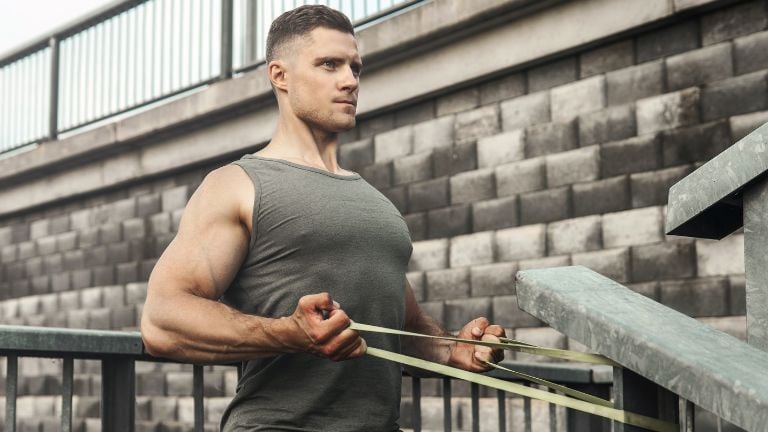
- How Resistance Band Train You Back
- How Resistance Band Work
- 10 Best Resistance Band Back Exercises At Home
- 1. Resistance Band Bent Over Row
- 2. Resistance Band Lat Pulldown
- 3. Resistance Band Face Pull
- 4. Standing Band Row
- 5. Resistance Band Pull Apart
- 6. Band Pullover
- 7. Seated Row With Resistance Bands
- 8. Band Assisted Pull Up
- 9. Resistance Band Deadlift
- 10. Band Upright Row
- How To Train Complete Back With Resistance Band
- At Home Resistance Band Back Workout Routines
- Band Back Workout Routine For Beginner
- Band Workout Routine For Intermediate
- Benefits of Resistance Band Back Workouts
- Understand Your Back Muscles
- FAQs
- Best Resistance Band Exercises For Upper Back
- What Are The Best Resistance Band Exercises For Lower Back?
- How often should I do resistance band back exercises?
- Are resistance band back exercises effective for building muscle?
- Can resistance band back exercises help improve posture?
- Conclusion
- References
How Resistance Band Train You Back
You can train your back using various gym equipment or your own bodyweight. Here, we focus on how a resistance band can help you train your back effectively.
Resistance bands are excellent tools for back training because they improve muscle activation and help establish a better mind-muscle connection.
Resistance bands provide a unique advantage due to their linear variable resistance (LVR). It puts these muscles under tension and makes them work harder than usual.
This overloads the back muscles, causing microtears and muscle damage. After that, the body repairs and grows the back muscles.
How Resistance Band Work
Resistance bands provide unique tension during both concentric and eccentric phases of back exercises. This means that you feel resistance when you contract the muscle (concentric phase) and lengthen the muscle (eccentric phase).
- The concentric phase is the shortening of the muscle, such as when you lift a weight.
- The eccentric phase is the muscle lengthening, such as when you lower the weight.
Imagine stretching a rubber band. It resists and wants to return to its original size. Well, resistance bands work similarly. When you stretch them, they provide a kind of push against you. The cool thing is that when you allow the bands to return slowly and in control, they’re trying to pull you, which makes your muscles work even more.
To maximize your back workouts with resistance bands, take control of the movement—don’t let the bands snap back without your guidance. Doing so will effectively strengthen your muscles during each exercise’s contracting and lengthening phases.
10 Best Resistance Band Back Exercises At Home
The band-back workout has the good muscle activation. It allows you to perform pulldowns, rows, and reverse fly exercises that target every muscle fiber in your back.
Here are the best exercises you can do with a band to build a bigger and wider back: These exercises will hit your back from all angles.
1. Resistance Band Bent Over Row
Resistance band bent over rows are a popular back exercise that targets the muscles of the upper back, including the rhomboids, trapezius, and latissimus dorsi. They are a compound exercise that also works your arms, and core muscle.
This exercise helps to improve postures by targeting the muscles responsible for proper posture, such as the rhomboids and trapezius. It can also reduce the risk of rounded shoulders.
Other variations of band bent over rows to build bigger and stronger back at home.
- Single-Arm Resistance Band Rows: This variation trains The back muscles unilaterally. Create better mind-muscle Connection.
- Underhand Grip Resistance Band Rows: Switching to an underhand grip targets your biceps and lower lats.
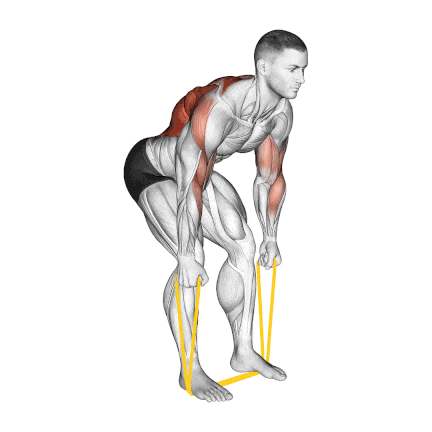
How To Do
- Stand on the resistance band with your feet hip-width apart. Hold the band’s ends in each hand.
- Bend at your waist and keep your back straight and your torso parallel to the ground.
- Avoid rounding or arching your back. Maintain a neutral spine.
- Engage your core and pull the resistance band towards your abdomen.
- Squeeze your shoulder blades together at the top of the movement.
- Slowly release the tension and return to the starting position.
2. Resistance Band Lat Pulldown
The resistance band lats pulldown can be done anywhere, so it’s a good option for home workouts or while traveling.
It is a compound exercise that engages multiple muscle groups of the back, specifically the latissimus dorsi (lats) and teres major.
There are some variations of the resistance band lat pull-down to add to your back workout:
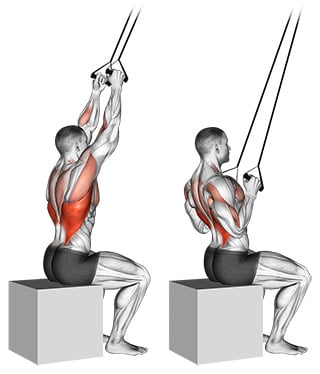
- Close-grip lat pulldown: Hold the resistance band with a closer grip. This will target the inner lats more.
- Wide-grip lat pulldown: Wide grip will target the outer lats more.
- One-arm pulldown: Work on each part separately and make your weaker side as strong as your stronger side.
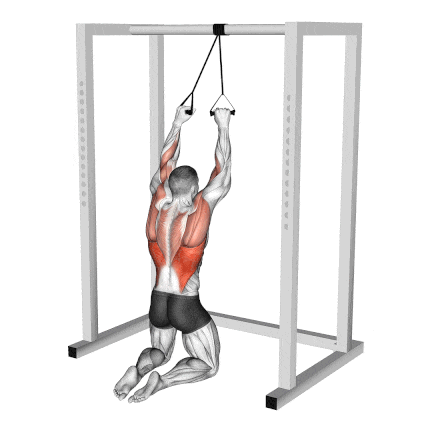
How To Do
- Attach the resistance band to a sturdy anchor point above your head, such as a door frame.
- Kneeling and grasping the resistance band with an overhand grip.
- Step back to create tension in the band. Engage your core and slightly lean back.
- Pull the band down towards your chest. Squeeze your shoulder blades together at the end of the movement.
- Slowly release the tension and return to the starting position.
- Make sure you control the movement both on the way down and up.
- Do 3–4 sets of 10–12 repetitions.
3. Resistance Band Face Pull
Resistance Band Face Pulls are a fantastic shoulder exercise that primarily targets the rear deltoid muscles and upper back muscles.
They improve shoulder strength, range of motion, and posture by strengthening the muscles that control shoulder retraction and external rotation.
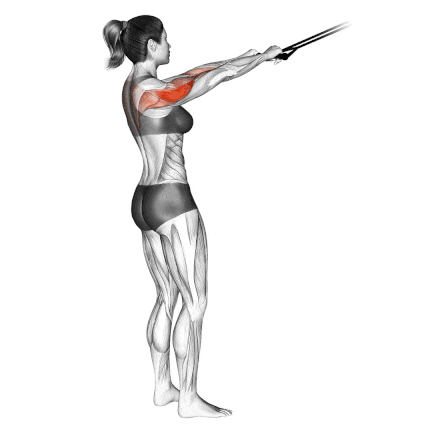
How To Do
- Anchor the band at shoulder height and stand holding the handles.
- Maintain upright posture – don’t lean back.
- Pull the handles toward your face with elbows flared out. Avoid shrugging or raising your shoulders.
- Squeeze shoulder blades together as you pull.
- Slowly return to the start position.
- Complete 10–15 reps.
4. Standing Band Row
The standing band row helps build strength and muscle mass in the upper back and promotes a more defined and sculpted back.
This exercise primarily targets the upper back muscles, including the rhomboids, trapezius, rear deltoids, and the biceps and core.
You can also try the one-arm band row, which focuses on working one side at a time and reduces the risk of muscle imbalances.
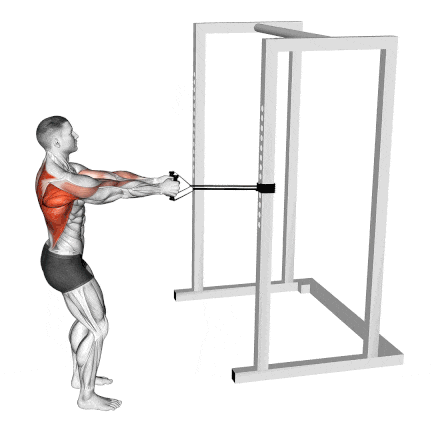
How To Do
- Position your feet shoulder-width apart and hold the resistance band handles in each hand.
- Step back to create tension in the resistance band.
- Your arms should be fully extended, and your body should lean slightly forward from your hips.
- Pull the resistance band handles towards your rib. Squeeze your shoulder blades at the top of the movement.
- Do not use momentum to pull the resistance bands. Focus on controlled movements.
- Slowly extend your arms back to the starting position.
- Exhale as you pull, and inhale as you release.
5. Resistance Band Pull Apart
This movement can be done on shoulder day, as it targets the rear delts. However, we also like to hit it on a back day, as the rear delts often need to double the work each week.
The bands pull apart will work your rhomboids, rear delts, and traps. It’s a great shoulder and upper back exercise.
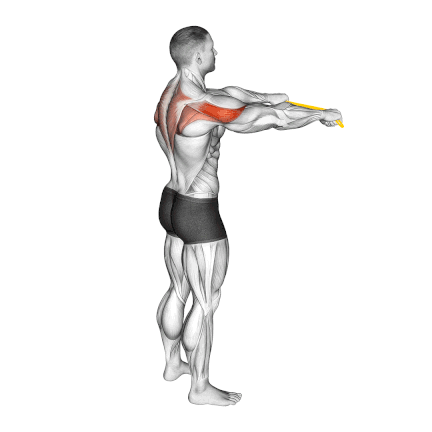
How To Do
- Stand with your feet shoulder-width apart, keeping a slight knee bend.
- Hold the exercise band in front of you with your hands slightly lower than your shoulders.
- Keep your elbows slightly soft to avoid hyperextending the joint.
- Squeeze the shoulder blades together and open the arms out to either side, pulling the band apart and squeezing your rhomboids.
- Return to start and repeat, keeping tension on the band the entire time.
6. Band Pullover
The lying band pullover is a great alternative to the barbell or dumbbell pullover. It is the best band exercise for building a strong rib cage and serratus anterior muscle, which is necessary for a complete chest and back.
Band pullovers are an effective compound exercise that engages both the chest muscles and the lats (latissimus dorsi), building upper body mass and strength.
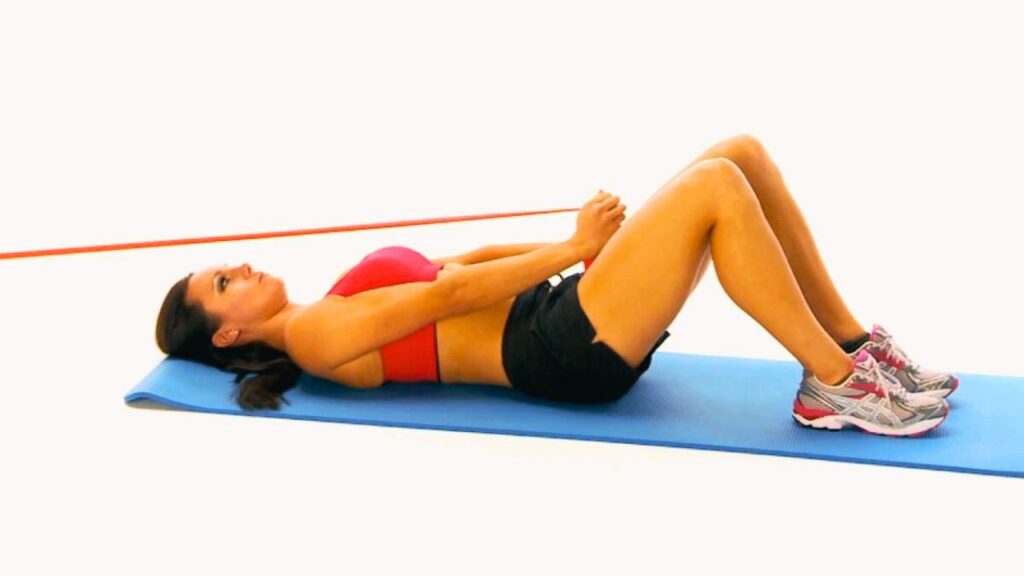
How To Do
- Anchor the resistance band securely at a low point. Lie down on a bench or on the floor.
- Hold the band’s handles above your chest with your arms fully extended.
- Keep a slight bend in your elbows and lower your arms backward in an arc-like motion.
- Pause, and then slowly pull the handles back up to the starting position. Repeat for desired reps.
- Do the exercise slowly and do not use momentum.
7. Seated Row With Resistance Bands
Seated Row with Resistance Bands primarily target the traps, latissimus dorsi, rhomboids, rear delts and biceps. It will also work your erector spinae, as you need your lower back to stabilize your movement.
Resistance bands are easy to carry and use, so you can do seated rows almost anywhere.
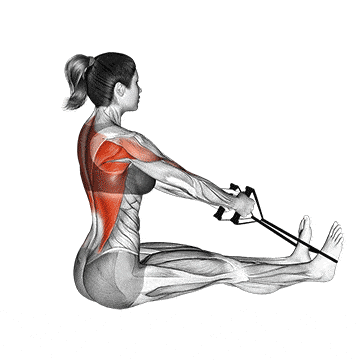
How To Do
- Sit on the floor with your legs extended. Loop the resistance band around the soles of your feet and hold one end in each hand.
- Keep your posture erect and your lower back slightly arched.
- Retract your shoulder blades as you pull the band back.
- As the handles touch your body, squeeze your shoulder blades together.
- Then, reverse direction, slowly returning to the start position.
8. Band Assisted Pull Up
A band-assisted pull-up is a variation of the pull-up that uses a resistance band to help you lift your body weight. This makes it a good choice for people who can’t do a regular pull-up yet.
It’s a great way to build up your upper body and strengthen your grip.
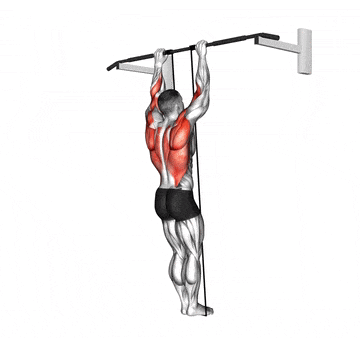
How to Do
- Secure the resistance band to a pull-up bar or other sturdy anchor point.
- Depending on the level of assistance needed, place one or both feet in the resistance band
- Grasp the pull-up bar with an overhand grip, hands slightly wider than shoulder-width apart.
- Pull yourself up towards the bar by squeezing your shoulder blades.
- Pause at the top of the movement, then slowly lower yourself back to the starting position.
9. Resistance Band Deadlift
The deadlift is the King of all exercises. This power exercise is designed to build an overall physique that uses more muscles than any other exercise.
Resistance band deadlifts are a variation of the traditional deadlift exercise that utilizes a resistance band for added resistance. This exercise targets the legs, glutes, back, and core muscles, providing a full-body workout.
It is a versatile exercise that can be modified to fit your fitness level and goals. For example, you can use a lighter resistance band if you are a beginner or a heavier resistance band if you are more advanced.

How to Do
- Stand on the resistance band with your feet hip-width apart. Hold the handles with an overhand grip.
- Keep a slight bend in your knees and your chest lifted.
- Hinge forward at the hips, keeping your back straight and core engaged.
- Start the upward movement by pushing your hips forward and bending your torso.
- Slowly release the tension and return to the starting position.
- Ensure you go through the full range of motion and correct your form.
10. Band Upright Row
If you’re looking to increase shoulder and upper back strength, try the resistance band upright row.
The band upright row exercise that targets the muscles of the shoulder and upper back, including the deltoids, trapezius, as well as the rhomboids, and even the biceps — making it a great addition to any full-body workout.
The exercise is named “upright row” because the weight is lifted up in a vertical, or upright, direction.
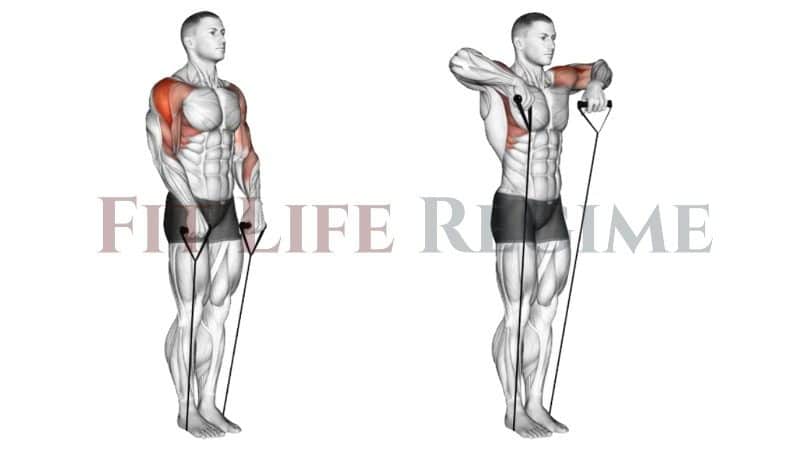
How To Do
- Stand with your feet shoulder-width apart. Start with a lighter band and work your way up.
- Hold a resistance band in each hand with an overhand grip. Let the band rest against your thighs.
- Pull hands straight up toward the chin.
- Pause at the top of the movement to feel your muscles contract.
- Slowly lower the band back to the starting position.
How To Train Complete Back With Resistance Band
You can do many resistance band exercises at home to completely train your back.
- Bent Over Band Rows: It targets the Lats, rhomboids and middle trapezius.
- Face Pulls: Target the rear deltoids and upper traps and help improve shoulder mobility and posture.
- Band Pull-apart: This exercise works upper back muscles, including the rear deltoids and rhomboid muscles.
- Lats Band Pulldowns: They provide effective Lat engagement and strengthen upper body strength.
- Band Good Mornings: It is an excellent exercise to strengthen your lower back and hamstrings.
- Seated Rows: Focusing on multiple back muscles and building mid-back strength.
- Assisted Pull-Ups: Use resistance bands to assist you in performing pull-ups, which will build upper body strength.
At Home Resistance Band Back Workout Routines
This workout contains multiple band exercises designed to target all the muscles in your back and increase overall muscle mass.
This workout plan is a starting point that can be adjusted based on individual fitness levels and goals.
Band Back Workout Routine For Beginner
| Exercise | Sets | Reps | Rest |
|---|---|---|---|
| Standing Band Row | 3-4 | 8-10 | 60-90 seconds |
| Band Pull Apart | 3-4 | 8 | 60-90 seconds |
| Band Reverse Fly | 4 | 8-10 | 60-90 seconds |
Band Workout Routine For Intermediate
| Exercise | Sets | Reps | Rest |
|---|---|---|---|
| Single Arm Band Row | 4 | 8-10 | 45-60 seconds |
| Band Deadlift | 3-4 | 10-12 | 45-60 seconds |
| Band Pullover | 4 | 8-10 | 45-60 seconds |
| Seated Band Row | 3 | 10-12 | 45-60 seconds |
Benefits of Resistance Band Back Workouts
Here are many reasons why resistance band-back workouts are essential to your fitness regimen.
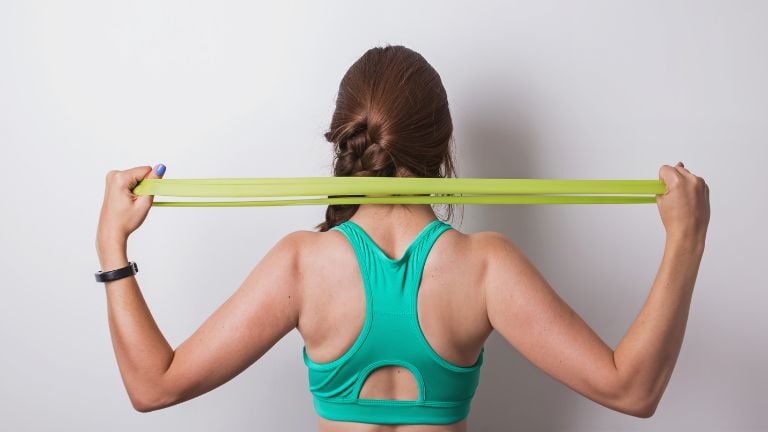
- Resistance bands enhance muscle activation and help establish a better mind-muscle connection, which can lead to more effective and targeted back muscle engagement.
- They are lightweight, portable, and can be used anywhere.
- They are a low-impact form of exercise that puts less stress on your joints than other forms of exercise, such as running or jumping. It is an excellent option for people with joint pain or injuries
- The elastic tension of resistance bands facilitates smoother and more controlled movements.
- Resistance band-back exercises not only target the back muscles and but also engage other muscle groups, such as the core and posterior chain. This can lead to improved overall strength, stability, and posture.
- They are affordable and widely available. They offer a cost-effective alternative to traditional gym equipment for back workouts.
Understand Your Back Muscles
The back is a complex area of the body that consists of various muscles responsible for supporting the spine, facilitating movement, and maintaining
The muscles of the back can be divided into three groups – superficial, intermediate, and deep:
- Superficial — associated with movements of the shoulder.
- Intermediate — associated with movements of the thoracic cage.
- Deep/Intrinsic Muscles — associated with movements of the vertebral column.1
The superficial back muscles are situated underneath the skin and superficial fascia. The muscles in this group are:
- Latissimus dorsi (lats), the largest muscle in the upper part of your body. It starts below your shoulder blades and extends to your spine in the lower part of your back.
- Levator scapulae, a smaller muscle that starts at the side of your neck and extends to the scapula (shoulder blade).
- Rhomboids, two muscles that connect the scapula to the spine.
- Trapezius (traps): These muscles start at the neck, go across the shoulders, and extend to a “V” in the lower back.
The erector spinae is a deep back muscle that starts from the lower spine and extends up to the neck. It is responsible for extending and rotating the spine. The erector spinae is a key part of the lower back and keeps the body working well.

FAQs
Best Resistance Band Exercises For Upper Back
Here is a list of the best band exercises for training the upper back and building a well-developed upper body.
- Resistance Band Rows
- Band Face Pulls
- Single-Arm Rows With Band
- Lat Pulldowns
- Straight-Arm Pulldowns
- Band Pull-Aparts
- Resistance Band Seated Rows
- Band-Assisted Pull-Ups
- Resistance Band Upright Rows
- Band-Assisted Renegade Rows
What Are The Best Resistance Band Exercises For Lower Back?
Here’s a list of the best lower back band exercises that help build a strong back.
- Hyperextensions (Back Extensions)
- Band Good Mornings
- Band Pull-Throughs
- Deadlifts with Bands
- Single-leg deadlifts with Bands
- Romanian Deadlifts with Bands
- Bent-Over Rows with Bands
- Band-Assisted Superman
- Band-Assisted Reverse Hyperextensions
- Band-Assisted Hip Thrusts
How often should I do resistance band back exercises?
You can do resistance band back exercises 2-3 times per week. If you are new to resistance training, you may want to start with 1-2 times per week and gradually increase the frequency as you get stronger.
Are resistance band back exercises effective for building muscle?
Yes, resistance band back exercises can be effective for building muscle. Resistance bands provide added resistance and can help improve muscle activation and mind-muscle connection.
Can resistance band back exercises help improve posture?
Yes, resistance band back exercises can help improve posture. The exercises that target the muscles responsible for good posture, such as the erector spinae and core muscles, can improve posture and lessen the chance of lower back discomfort.
Conclusion
Resistance band exercises are a great way to build a strong and well-defined back. They are a versatile and affordable option that can be done at home or at the gym. There are many exercises that you can do with resistance bands, so you can find ones that work for you and that you enjoy doing.
When doing resistance band exercises, it is important to use a resistance band that is challenging but not too difficult. You should be able to do 8–12 repetitions of each exercise with good form.
References
- 1. Lopes JSS, Machado AF, Micheletti JK, de Almeida AC, Cavina AP, Pastre CM. Effects of training with elastic resistance versus conventional resistance on muscular strength: A systematic review and meta-analysis [published correction appears in SAGE Open Med. 2020 Sep 9;8:2050312120961220]. SAGE Open Med. 2019;7:2050312119831116. Published 2019 Feb 19. doi:10.1177/2050312119831116
- 2. Bergquist R, Iversen V, Mork P, Fimland M. Muscle Activity in Upper-Body Single-Joint Resistance Exercises with Elastic Resistance Bands vs. Free Weights. Journal of Human Kinetics. 2018;61(1): 5-13. https://doi.org/10.1515/hukin-2017-0137
- Jeno SH, Varacallo M. Anatomy, Back, Latissimus Dorsi. [Updated 2022 Apr 5]. In: StatPearls [Internet]. Treasure Island (FL): StatPearls Publishing; 2022 Jan-. Available from: https://www.ncbi.nlm.nih.gov/books/NBK448120/

Manish is a NASM-certified fitness and nutrition coach with over 10 years of experience in weight lifting and fat loss fitness coaching. He specializes in gym-based training and has a lot of knowledge about exercise, lifting technique, biomechanics, and more.
Through “Fit Life Regime,” he generously shares the insights he’s gained over a decade in the field. His goal is to equip others with the knowledge to start their own fitness journey.
